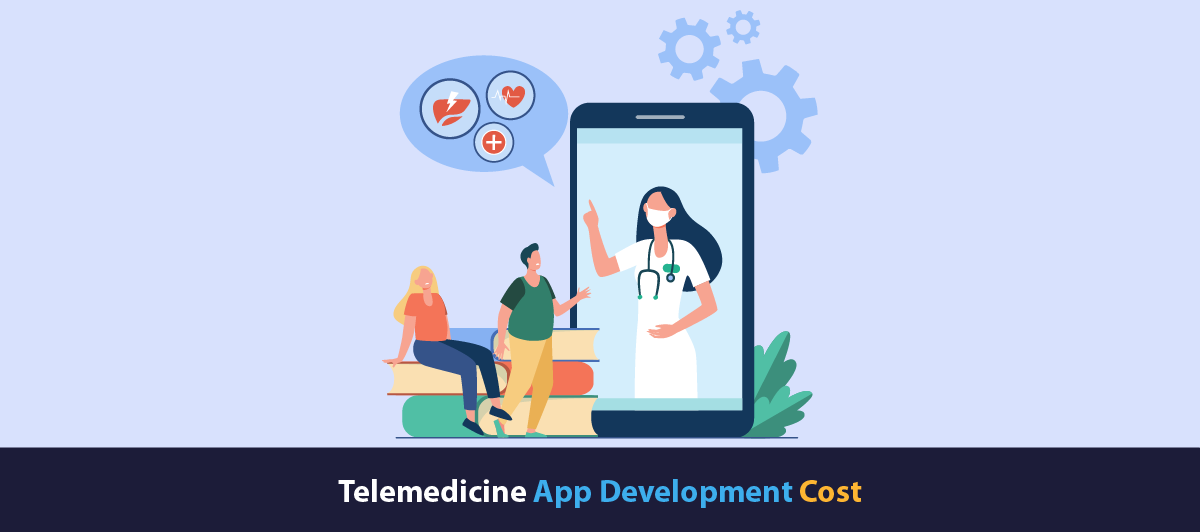What Will Be Estimate Cost Of Telemedicine App Development
Quick Summary: Explore the future of healthcare with an innovative custom telemedicine app! Demonstrate the power of technology to make healthcare simpler and more convenient for patients around the world. Transform the way health care is delivered from virtual counseling to remote monitoring. Reap the benefits of reducing surgical costs, increasing patient satisfaction and improving access to healthcare. Embrace innovation and elevate your healthcare services with a customized Telemedicine app development!
Introduction
In today’s fast-paced world, the demand for telemedicine services has increased exponentially. With the ease of accessing healthcare remotely, telemedicine program have become essential tools for patients and healthcare professionals. As healthcare continues to evolve, Telemedicine App Development is a necessity.
But before building telemedicine apps you need to analyze the cost of developing!
The estimated cost of a telemedicine software development and app development depends on a variety of factors. These factors include features, complexity, platform compatibility, security measures, and development team expertise. Flexible resources such as video consulting, scheduling work, electronic prescribing, secure messaging, and extensive patient data management impact costs.
While the initial investment in a telemedicine app is a bit complex, it is important to consider the long-term benefits that telehealth services have. These apps streamline healthcare delivery, improve patient access to treatment, reduce administrative burdens, and improve overall healthcare.
In this article, we’ll discuss key factors that affect the cost of developing a telemedicine or mobile telehealth app or apps.
So, keep reading!
Overview To Telemedicine App Development
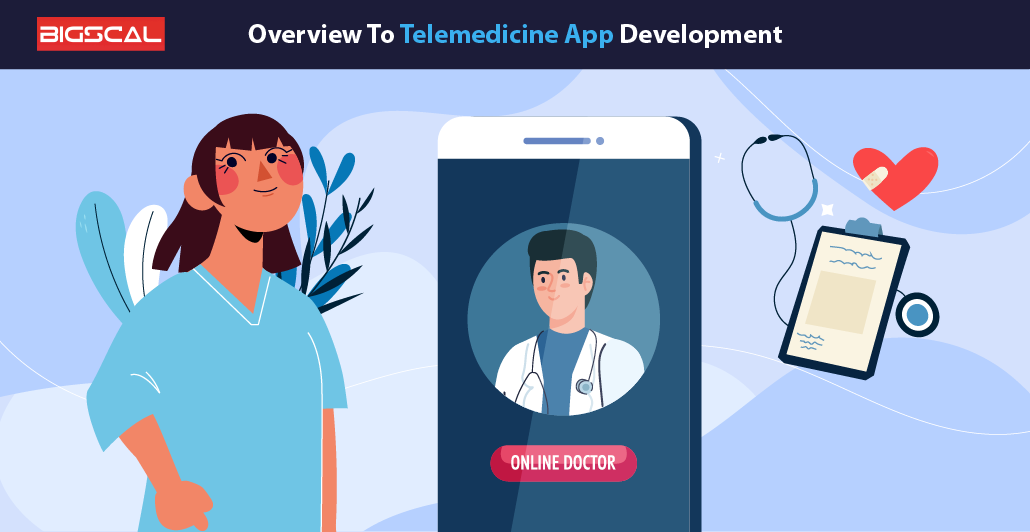
The development of mobile telemedicine app involves the creation of a digital platform. These platforms enable healthcare providers to provide remote medical services to patients. The process begins by identifying the target audience and explaining the telehealth app development’s goals. These are as honest advice, appointment scheduling, and patient health which will be monitored remotely.
The next step is to design the user interface (UI) and user experience (UX) to ensure easy navigation and interaction for healthcare professionals and patients. This includes creating soft features. These features are as appointments will work, video conferencing for a virtual care consultation, secure messaging, electronic health record (EHR) integration to access patient information In addition.
To protect patient data and ensure privacy, manufacturers must prioritize compliance with security and health regulations. These regulations are as HIPAA (Health Insurance Portability and Accountability Act). This includes implementing encryption protocols, access controls, and regular security audits of medical devices.
Integration with third-party services such as payment gateways, pharmacy dispensing services, and remote medical device communications improves app performance. Testing to detect and prevent errors it is important to answer any usage issues before starting the app.
Irresistible Need Of Telemedicine Software or App For Healthcare Provider?
Telemedicine solutions software or telehealth app development offers many benefits for healthcare professionals, patients, and the healthcare system as a whole. Here are some reasons and Uses of Telemedicine App Development why it is worthwhile to develop telemedicine software or an app:
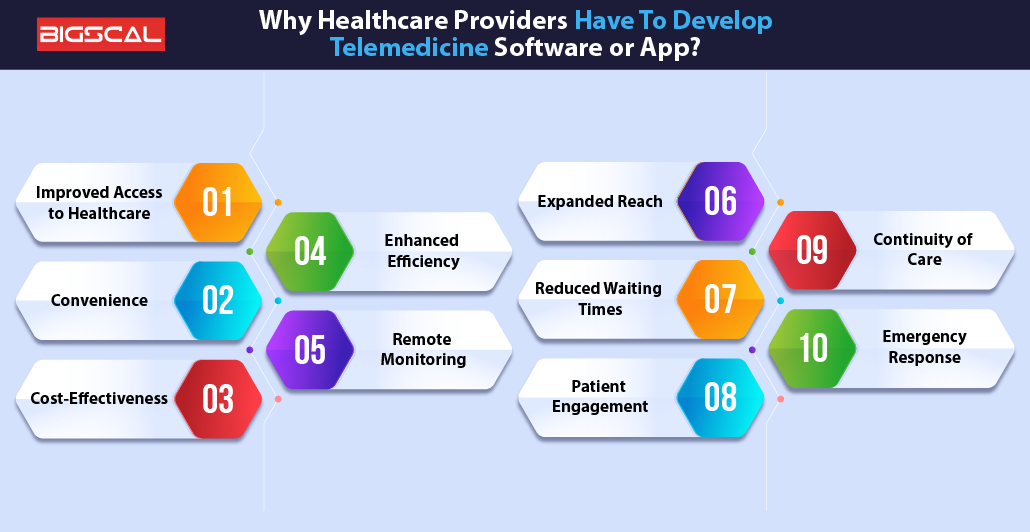
Improved Access to Healthcare
Telemedicine software or apps can play an important role in improving healthcare, especially for individuals who live in remote or underserved areas. Telemedicine software costs and enables patients to consult with healthcare providers without having to travel physically. It reduces distance, travel and time barriers.
Additionally, this increased accessibility ensures that individuals are able to access timely medical advice, diagnosis and treatment. And it leads to better health outcomes and can prevent sufficient deterioration of health conditions towards shared care.
Convenience
Telemedicine apps offer unparalleled convenience to patients and healthcare professionals. Patients can schedule appointments, seek advice, and receive treatment in the comfort of their home or work. This eliminates the need for long wait times in hospitals.
It reduces stress and increases overall patient satisfaction. For health care providers, telemedicine offers flexibility in scheduling, time management, and the ability to care for larger numbers of patients without compromising quality of care.
Cost-Effectiveness
The use of telemedicine apps can result in significant cost savings for healthcare providers and patients. By eliminating the need for in-person visits, telemedicine reduces office maintenance, personnel resources, and overhead costs.
Patients save money on travel, parking, and about potential childcare or eldercare costs when they opt for a virtual check-in. In addition, telemedicine can reduce the cost of health care in terms of missed work days due to medical appointments. Moreover, it reduces the overall financial burden of cost on health care systems.
Enhanced Efficiency
By leveraging digital technology, telemedicine helps systematize the work-flow within the organization and increase efficiency across the enterprise. Now, healthcare providers have more efficient appointment scheduling, access to patient records remotely and are able to work as a team with their co-workers through all means of communication.
This simple workflow is automatic which effectively relieves the administrative stress and improves the communication between the team of healthcare care providers and contributes to the quality and continuity of patient care. It is patients that experience the advantages of medical advice, fast arrival at the health facilities, refilling medications quickly at the pharmacies and easy communication among appointed healthcare personnel.
Remote Monitoring
Telemedicine apps allow patients to monitor their health status remotely, especially those with chronic diseases or receiving post-operative care. Through the integration of wearable devices, sensors and digital health tools into telemedicine platforms, healthcare professionals can remotely monitor vital signs, medication adherence and progress.
This real-time assessment facilitates engagement early, adapted personalized care and early use of health information to improve patient outcomes and reduce hospital readmissions. It also empowers and compels you to actively participate in your service journey promoting management of chronic conditions between health visits.
Expanded Reach
Healthcare providers are developing telemedicine apps to extend their reach beyond traditional barriers. This technology enables patients to quickly access health services, especially in remote or underserved areas. Through telemedicine platforms, patients can communicate with health care providers no matter where they are, improving overall health care access and outcomes.
Reduced Waiting Times
Telemedicine apps help reduce wait times for patients by providing virtual appointments. Instead of waiting for hours in a clinic or hospital, patients can schedule appointments online and receive timely medical advice.
This not only improves patient satisfaction, but also optimizes healthcare provider scheduling. Thereby optimizing resource utilization.
Patient Engagement
Telemedicine promotes patient engagement by providing convenient ways to communicate with health care providers. Patients can access their medical history, schedule appointments and receive follow-up care through these sessions.
This increased communication promotes better communication between patients and health-care professionals. It improves health outcomes and increases patient satisfaction.
Continuity of Care
Telemedicine platforms provide a way for the involvement of various health-oriented personnel while delivering the holistic healthcare process to the patients who need it most. Patients will no longer need to go to the hospital or clinic to receive routine evaluations, medication management, and consultations. These services are instead delivered to the patient at home and this is a way to improve their overall healthcare. This continuity of care is increasingly appropriate for people suffering from chronic health conditions which are amenable to frequent medical interventions.
Emergency Response
Telemedicine is a critical factor in emergencies by granting instant access to more choices concerning data and prognosis. Thus, patients will have access to online consultations and the discrepancy would be reduced at the community paramedicine stations, which will enable immediate reaction to critical situations. This emergent situation calls for immediate intervention and the consequences of it in terms of patient outcomes can be massive. Telemedicine, therefore, is an invaluable tool worn by every healthcare employee in an emergency.
Why Is it Necessary To Analyze Telemedicine App Development Cost?
Analyzing the cost of developing a telemedicine app is important for several main reasons:
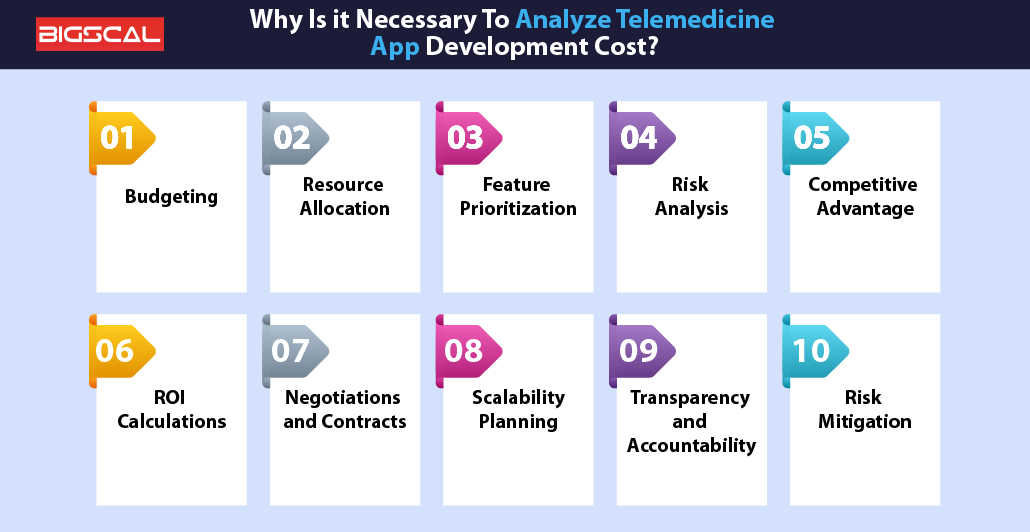
- Budgeting: Understanding costs helps create realistic budgets, and ensures that resources are allocated efficiently and effectively.
- Resource allocation: Allows for appropriate allocation of resources such as money, time and labor, and prevents excessive or unnecessary allocation during development.
- Feature Prioritization: Cost analysis helps prioritize resources based on importance and feasibility within the given budget, ensuring that required activities are included.
- Risk Analysis: Cost analysis enables a better risk assessment by identifying potential cost overruns, delays, or limitations in development.
- Competitive Advantage: Knowing development costs helps compare to competitors, ensuring competitive pricing strategies and pricing metrics.
- ROI Calculations: Cost analysis helps calculate the return on investment (ROI) of a telemedicine app, helping stakeholders make informed decisions about the feasibility of the project.
- Negotiations and Contracts: This provides a basis for negotiations with development teams or vendors, and helps to draft contracts that accurately specify deliverables, timelines, and cost structures.
- Scalability planning: Understanding costs facilitates scalability planning, allowing future updates, developments and maintenance of the telemedicine app without significant financial pressure.
- Transparency and Accountability: Transparent cost analysis encourages accountability among stakeholders, and ensures clear communication and aligned expectations throughout the development process.
- Risk Mitigation: Understanding telehealth software development costs early can mitigate potential risks related to funding constraints early in the development cycle, reducing the likelihood of project failure or cost escalation later on.
Factors To Analyze Cost Of Telemedicine App Development
There are various factors in developing a telemedicine app that can affect the overall telemedicine software cost and platform cost. Here are some of the major factors that can affect the Cost To Make An App:
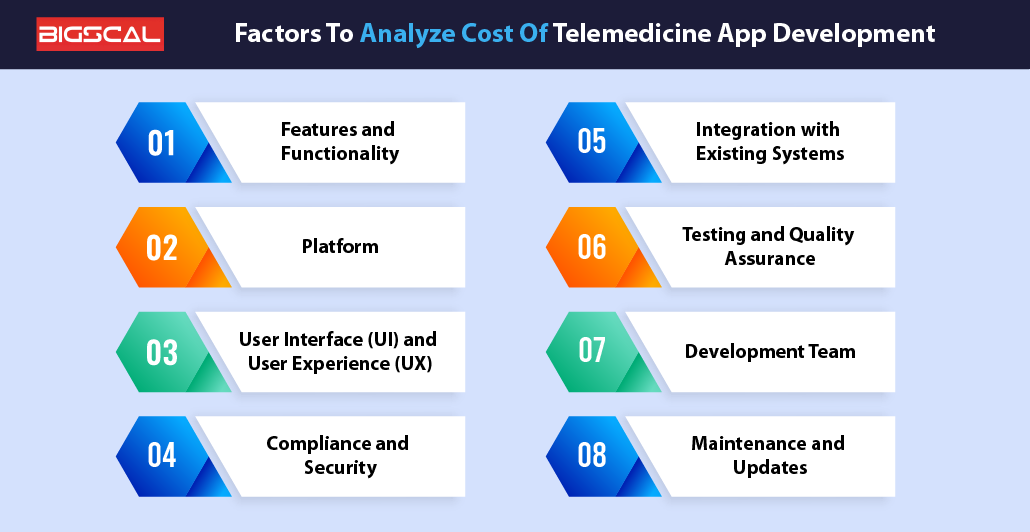
Features and Functionality
The price of your app will depend upon complexity and features that it would have. Coming to the point standard functionalities, video counseling, appointment scheduling, secure messaging, electronic prescription and patient record management are the common ones. Though these technologies are improving, like artificial intelligence based diagnostics or remote monitoring, they still tend to be relatively expensive.
Platform
If you opt for a single-platform application (e.g. iOS or Android) or choose a cross-platform application (Native app), this will definitely affect your costs. Development of cross-platform may seem promising at the beginning but native app deployment will give remunerative and satisfactory results.
User Interface (UI) and User Experience (UX)
A successful UI/UX is a critical parameter in attaining users’ satisfaction and active participation. By implementing intuitive and usability interfaces, one can put a lot of resources in building, testing, and reworking the functionality of the interface to get the best results and also speed up the process.
Compliance and Security
Telemedicine platforms and apps need to observe the rules of healthcare regulations like HIPAA (Health Insurance Portability and Accountability Act) in the United States. Equivalent regulations ought to be observed in all countries, too. Security measures must be developed, tested, and then audited by an independent auditor which adds additional development cost and demand compliance.
Integration with Existing Systems
In case the app has to mesh with other systems such as EHRs, payment gateways or passing third-party APIs for lab results and doctors’ prescriptions, it means that there will be complexity and considerably higher costs in the app development process.
Testing and Quality Assurance
Proper testing and good quality (QA) techniques are a must to ensure that there are flawless operations, and user experience does not have glitches and breaks. Before we start the full testing, budget testing and QA check are important and may influence the cost altogether.
Development Team
The skillfulness of the telehealth application or software development team as a greatly variable component is actively involved in cost determination. In the majority of instances hiring experienced programmers, designers, testers and project managers will not be cheap. However, the rate of developers’ salary per hour could change depending on the location of their placement.
Maintenance and Updates
Maintenance, updates, and ongoing support deliver healthcare services after the application is launched. Budgeting for post-launch costs is essential to ensure that the app remains operational, secure, and in compliance with changing health standards.
The Estimate Cost Of Telemedicine App Development Based On Above Factors
So, the telemedicine platform cost based on above factors are as follows:

Features
- Basic Features: A simple telemedicine app with basic features like video consultation, appointment scheduling, and secure messaging. This app can cost between $30,000 and $50,000
- Advanced features: If you want to include advanced features such as an electronic health record (EHR), AI-powered symptom checker, prescribing system, etc. The price of these apps can range from $50,000 to $100,000 or more.
Platform
- Developing for one platform (iOS or Android) is generally cheaper than developing for both. For each platform added, the cost can increase by 50% to 100%.
Design Complexity
- Complex Design: Easy-to-use custom designs can add about $10,000 to $30,000 to the overall cost.
Regulatory Compliance
- Ensuring compliance with healthcare regulations such as HIPAA (Health Insurance Portability and Accountability Act) adds complexity and cost. Budget an additional $5,000 to $20,000 for compliance work.
Development Team Location
- The rate of development varies depending on the location of the development team. Compared to Eastern Europe, Asia, or Latin America, the numbers are higher in North America and Western Europe.
Testing and Maintenance
- Don’t forget to budget for testing, debugging and ongoing maintenance. This can amount to 20% to 30% of total development costs per year.
Considering these factors, the telemedicine startup costs can range from $30,000 for a basic application. And to $150,000 or more for a feature-rich, multi-platform application many with advanced functions and compliance mechanisms.
Approach Bigscal Technologies For Telemedicine Mobile App Development?
At Bigscal Technologies, we understand the increasing importance of accessible and efficient healthcare solutions, especially in today’s digital age. Our team of hardworking, experienced professionals are passionate about developing groundbreaking telemedicine mobile apps. These apps can change the way healthcare is delivered. When you choose Bigscal to develop your telemedicine app, you are making a choice of quality, innovation, and reliability. Additionally, we provide Custom Application Development services.
We prioritize understanding your unique needs and goals. Our personalized approach ensures that your telemedicine application is tailored. And it meets the specific needs of your healthcare facility or organization. We use the latest technology and industry best practices to achieve a seamless user experience for healthcare professionals and patients.
Our track record speaks for itself, as we have many successful projects. We are committed to transparency, timely delivery and ongoing support to ensure the success and scalability of your telemedicine solution. Hence, The partnership with Bigscal Technologies means unlocking the full potential of telemedicine to improve patient care.
Conclusion
The estimated cost of developing a telemedicine app can vary widely depending on a variety of factors. And you have read all the factors. Investing in telemedicine app development can improve patient outcomes. Not that these benefits help for delivering healthcare not only efficiently but also in line with the growing demand for remote healthcare solutions.
Thus, despite the initial investment, the long-term benefits and positive impact on healthcare accessibility and efficiency. Make telemedicine app is a worthwhile investment. It is a viable and useful strategy for healthcare professionals looking to innovate and deliver better patient care.
FAQ
What is telehealth business?
The telehealth industry involves the remote delivery of medical services through telecommunications technology. This includes virtual consultation, remote monitoring and digital health solutions to improve access to healthcare and patient outcomes.
Define telemedicine equipment costs.
Telemedicine equipment costs refer to the costs of acquiring and maintaining the technology. It is necessary for remote medical consultations such as video conferencing software, medical devices, and secure data communication systems.
How profitable is telehealth?
Telehealth can be even more profitable due to reduced costs, increased patient advocacy, and efficiencies. However, profitability varies depending on factors such as coverage, service offered and market demand.
What app is used for telehealth?
Several apps are used for telehealth, including Amwell, Doctor on Demand, Teladoc, and Zoom for Healthcare. These techniques enable remote counseling, digital health monitoring, and secure communication between patients and healthcare professionals.
What technology is needed for telehealth?
Technologies needed for telehealth include:
- Video Conferencing Software
- Secure Messaging,
- Electronic Health Record (Ehr) Systems,
- Remote Medical Devices,
- Reliable Internet Connectivity.
